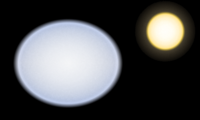Portal:Astronomy
Astronomy portal
Astronomy is a natural science that is the study of celestial objects (such as moons, planets, stars, nebulae, and galaxies), the physics, chemistry, and evolution of such objects, and phenomena that originate outside the atmosphere of Earth, including supernovae explosions, gamma ray bursts, and cosmic background radiation.
Astronomy is one of the oldest sciences. Prehistoric cultures have left astronomical artifacts such as the Egyptian monuments and Nubian monuments, and early civilizations such as the Babylonians, Greeks, Chinese, Indians, Iranians and Maya performed methodical observations of the night sky. However, the invention of the telescope was required before astronomy was able to develop into a modern science. Historically, astronomy has included disciplines as diverse as astrometry, celestial navigation, observational astronomy, and the making of calendars, but professional astronomy is nowadays often considered to be synonymous with astrophysics.
Selected article
Vega has been extensively studied by astronomers, leading it to be termed "arguably the next most important star in the sky after the Sun." Historically, Vega served as the northern pole star around 12,000 BCE and will do so again at 13,727 CE when the declination will be +86°14'. Vega was the first star other than the Sun, to have its photograph taken and the first to have its spectrum photographed. It was also one of the first stars to have its distance estimated through parallax measurements. Vega has served as the baseline for calibrating the photometric brightness scale, and was one of the stars used to define the mean values for the UBV photometric system.
In terms of years, Vega is only about a tenth the age of the Sun, but it is evolving so quickly that it has already approached the midpoint of its life expectancy, as has the Sun. It has an unusually low abundance of the elements with a higher atomic number than that of helium. Vega is also a suspected variable star that may vary slightly in magnitude in a periodic manner. It is rotating rapidly with a velocity of 274 km/s at the equator. This is causing the equator to bulge outward because of centrifugal effects, and, as a result, there is a variation of temperature across the star's photosphere that reaches a maximum at the poles. From Earth, Vega is being observed from the direction of one of these poles.
Did you know
- ... that Jerry Nelson is the principal designer and project scientist for the Keck telescopes?
- ... that five supernovae have been found in the Messier 100 spiral galaxy?
- ... that the Antlia Dwarf galaxy may have distorted the shape of its neighbour NGC 3109 one billion years ago?
- ... that AP Columbae, the closest young star known, formed after the dinosaurs became extinct?
- ... that a planet was discovered around the star MOA-2009-BLG-387L after it eclipsed a background star, refracting the star's light in a process called gravitational microlensing?
Categories
Astronomy : Archaeoastronomy - Astrophysics - Calendars - Catalogues - Celestial coordinate system - Celestial mechanics - Cosmology - Images - Large-scale structure of the cosmos - Observatories - Planetary science - Telescopes - Universe
Biographies : Astronomers - Other people - Amateur Astronomers
Astronomical objects : Lists - Galaxies - Nebulae - Planets - Stars
Spaceflight : Human spaceflight - Satellites - SETI - Spacecraft
Projects
Selected picture
Mimas is a moon of Saturn. It was discovered in 1789 by William Herschel, after whom the large crater in the image is named. It is the twentieth-largest moon in the Solar System, and the smallest astronomical body that is known to be rounded in shape because of self-gravitation. This photograph of Mimas was taken by the unmanned spacecraft Cassini in 2010.
October anniversaries
- 1 October 2003 – The Japan Aerospace Exploration Agency is formed from a merger of three previous Japanese space agencies
- 4 October 1957 – The first artificial satellite, Sputnik 1, is launched into orbit by the Soviet Union, triggering the Space Race
- 15 October 2003 – The People's Republic of China becomes the third nation to send a human into space when Yang Liwei is launched into outer space aboard Shenzhou 5
Things you can do
|
Here are some Open Tasks :
Astronomy featured article candidates:
Astronomy articles for which peer review has been requested: |
Wikibooks
These books may be in various stages of development. See also the related Science and Mathematics bookshelves.
- Astronomy
- GAT: A Glossary of Astronomical Terms
- Introduction to Astrophysics
- General relativity
- Observing the Sky from 30°S
- Observing the Sky from 40°N
Wikijunior
Astronomical events
All times UT unless otherwise specified.
| 1 October, 00:11 | New moon |
| 4 October, 11:13 | Moon at apogee |
| 8 October, 12:00 | Draconids peak |
| 13 October, 06:00 | Moon occults Neptune |
| 15 October | Uranus at opposition |
| 16 October, 04:23 | Full moon and penumbral lunar eclipse |
| 16 October, 23:41 | Moon at perigee |
| 21 October, 05:18 | Ceres at opposition |
| 21 October, 19:00 | Orionids peak |
| 27 October, 16:18 | Mercury at superior conjunction |
| 30 October, 17:38 | New moon |
| 31 October, 19:45 | Moon at apogee |
2016: January | February | March | April | May | June | July | August | September | October
2015: January | February | March | April | May | June | July | August | September | October | November | December
2014: January | February | March | April | May | June | July | August | September | October | November | December
2013: January | February | March | April | May | June | July | August | September | October | November | December
2012: January | February | March | April | May | June | July | August | September | October | November | December
2011: January | February | March | April | May | June | July | August | September | October | November | December
2010: January | February | March | April | May | June | July | August | September | October | November | December
2009: January | February | March | April | May | June | July | August | September | October | November | December
2008: January | February | March | April | May | June | July | August | September | October | November | December
2007: January | February | March | April | May | June | July | August | September | October | November | December
2006: January | February | March | April | May | June | July | August | September | October | November | December
2005: May | June | July | August | September | October | November | December
Basics
- What are portals?
- List of portals
- Featured portals
- Shortcuts to this page: Astronomy portal • P:ASTRO











